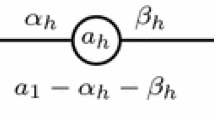Abstract
We consider a primitive distance-regular graph \(\varGamma \) with diameter at least 3. We use the intersection numbers of \(\varGamma \) to find a positive semidefinite matrix G with integer entries. We show that G has determinant zero if and only if \(\varGamma \) is Q-polynomial.
Similar content being viewed by others
References
Brouwer, A.E., Cohen, A.M., Neumaier, A.: Distance-Regular Graphs. Springer, Berlin (1989)
Hanson, E.: A characterization of Leonard pairs using the parameters \(\{a_i\}_{i=0}^d\). Linear Algebra Appl. 438, 2289–2305 (2013)
Jurišić, A., Terwilliger, P., Žitnik, A.: The \(Q\)-polynomial idempotents of a distance-regular graph. J. Comb. Theory Ser. B 100, 683–690 (2010)
Kurihara, H., Nozaki, H.: A characterization of \(Q\)-polynomial association schemes. J. Comb. Theory Ser. A 119, 57–62 (2012)
Nomura, K., Terwilliger, P.: Tridiagonal matrices with nonnegative entries. Linear Algebra Appl. 434, 2527–2538 (2011)
Pascasio, A.A.: A characterization of \(Q\)-polynomial distance-regular graphs. Discret. Math. 308, 3090–3096 (2008)
Terwilliger, P.: A characterization of \(P\)- and \(Q\)-polynomial association schemes. J. Comb. Theory Ser. A 45, 8–26 (1987)
Terwilliger, P.: A new inequality for distance-regular graphs. Discret. Math. 137, 319–332 (1995)
Terwilliger, P.: The subconstituent algebra of an association scheme I. J. Algebraic Comb. 1, 363–388 (1992)
Acknowledgements
The author would like to thank Professor Paul Terwilliger for many valuable ideas and suggestions. This paper was written while the author was an Honorary Fellow at the University of Wisconsin-Madison supported by the Development and Promotion of Science and Technology Talents (DPST) Project, Thailand.
Author information
Authors and Affiliations
Corresponding author
Electronic supplementary material
Below is the link to the electronic supplementary material.
Appendices
Appendix 1
Recall the distance-regular graph \(\varGamma \) with diameter D. Recall for \(0\le h \le D\)
We now give \(p^h_{2j}\) for \(h-2\le j \le h+2\).
We now give \(p^h_{3j}\) for \(h-3\le j \le h+3\).
Appendix 2
Recall the matrix G from Theorem 1. In this appendix we give G for \(D=3\).
Example 1
Assume \(D=3\). The rows and columns of G are indexed by the following matrices, in the specified order:

So the matrix G is \(12\times 12\). G has the form
where each block is a \(3\times 3\) symmetric matrix as shown below.
\(\mathbb {S}_1=b_2\mathbb {S}\), \(\mathbb {S}_2=a_2\mathbb {S}\) and \(\mathbb {S}_3=c_2\mathbb {S}\).
The matrix \(\mathbb {W}\) is symmetric with entries
From Appendix 1, we find
Rights and permissions
About this article
Cite this article
Sumalroj, S. A Characterization of Q-Polynomial Distance-Regular Graphs Using the Intersection Numbers. Graphs and Combinatorics 34, 863–877 (2018). https://doi.org/10.1007/s00373-018-1917-5
Received:
Revised:
Published:
Issue Date:
DOI: https://doi.org/10.1007/s00373-018-1917-5



